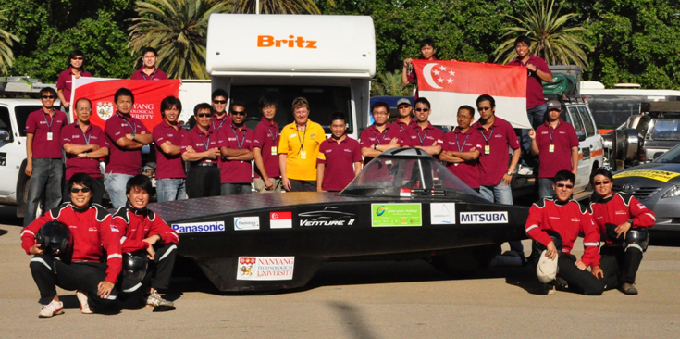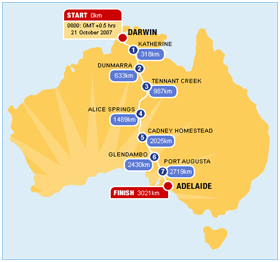Chassis, steering and wheels
The frame of the solar car is made of 6061-T6 aluminum for lightness and rigidity. To further reduce the weight of the car, holes were drilled into the
frame while ensuring that the car’s integrity is not compromised. The double wishbone suspension in the chassis makes tuning of the kinematics of the vehicle easier. There is also a dual-circuit braking system with separate hydraulic circuits so that if one brake fails, the driver is still able to
engage the other brake. The car has both front disc brakes and rear brakes. As a safety precaution, roll bars are designed as part of the chassis to minimise the injury of the driver in the event of a crash. The two 14” carbon fiber wheel rims at the front and the 16” carbon fiber wheel rim at the rear are mounted with Dunlop Solarmax tubeless tyres. These tyres have low rolling resistance, but are safe enough for driving on
public roads. Major steel bolts and nuts are also replaced with those made of titanium, which weigh only one-third of the former. |  |
Car Body
The 5m long and 1.8m wide body of Nanyang Venture II has an aerodynamic shape, which helps to prevent flow separation and to reduce drag coefficient. This lessens the need
to use energy to overcome air resistance. The body shells are made of honeycomb sandwiched between carbon fibre composite. This design makes for a very strong and lightweight body shell. The surface of the upper shell is covered with solar cells. The canopy is made of Perspex, which provides visual clarity without weighing down the car. Rear view and side view mirrors are placed inside the canopy to reduce aerodynamic drag. The canopy can be easily and quickly lifted for the
driver to get in and out of the car. The upper body shell also can be easily removed for maintenance purposes. |  |
Telemetry
Telemetry is a technology that allows remote monitoring and reporting of information. With this system on board, the team will be able to monitor the car's energy consumption,
solar energy capture and other parameters and free the driver to concentrate on driving. A real-time data acquisition and logging system known as CompactRIO from National Instruments is used in this project. The system is capable of collecting different types of data, from GPS information for tracking of vehicle location
to temperature, current and voltages information for monitoring the performance of battery and solar modules. It also collects important data, such as weather conditions and vehicle speed, for post-race analysis. These readings will be logged onto the board memory of the CompactRIO and transferred real-time via a modem to the lead and chase vehicles escorting the solar car. This allows the team to react immediately to any changes and make necessary
adjustments to the race strategy in the shortest possible time. | 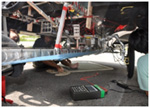 |
Battery
Lithium-ion cells, donated by Panasonic, are used because it is lightweight and has the highest energy density compared to other types of batteries. The 28S18P battery configuration
can provide 110V DC with a capacity is 52Ah. The battery box is designed such that there are spaces between all the individual cells for better ventilation and easy inspection. The battery box is also equipped with a battery management
system called BMS, which will help monitor individual cell condition to prevent it from overcharging.
| |
Solar Array
Nanyang Venture II uses solar energy to power the motor and electronic components as well as to charge the battery. Measuring 6.0m2, the solar array is constructed with
403 monocrystalline silicon photovoltiac cells, capable of producing 1.2kW of power at peak condition. Integrated with the solar cells system are devices called Maximum Power Point Trackers (MPPT), which regulate and extract maximum
power from the cells. | 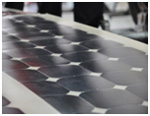 |
Propulsion
The Mitsuba hub motor used in Nanyang Venture II provides more than 98% of efficient power transmission, which is capable of propelling the car to a road-tested speed
of about 95km/hr. It is estimated that the maximum speed can be in excess of 120km/hr but this has not been verified by road tests.
The driver uses the lever control throttle to vary the speed of the car, making it easier
for him to drive at constant speed. The regeneration braking system in the car allows kinetic energy to be converted into electrical energy that is stored in the battery until needed. | |
Cockpit
To ensure that the solar car is road-worthy and safe to be driven on the public roads, high intensity LEDs are used for the lighting system (brake and signal lights) of the
solar car because it is lightweight and consumes less power. Horn and mirrors are placed in the cockpit. Proper seating and a five-point seat belt (FIA certified) are also provided for the driver to ensure a comfortable and safe
drive. The circuit breaker is placed within the driver’s reach to facilitate fast emergency cutoff when necessary. In addition to the cooling air vents in the canopy, the air temperature is measured and sent by telemetry
to the chase vehicle to assess the driver’s condition. Voice communications between the driver and the chase vehicle is maintained by a wireless link. | |
Logistics:
Logistics support plays a very important role in determining the performance of the team. This is crucial not only in the freighting of the solar car to and fro Singapore and Australia, but also in
providing for the needs of team members while in Australia. As the team will be camping in the desert most of the time, extensive planning is of utmost importance to ensure the team is well provided for. | |
Safety Measures:
To avoid driver fatigue, each driver drives for a maximum of 4 hours, after which there will be a change of driver. Other than ensuring that fire extinguishers and first aid kit are on hand for
emergencies, the team will also conduct regular checks on the condition of the car. Both drivers wear specially designed fire-retardant coverall and helmet. In addition, five team members have undergone first aid training to prepare
themselves for emergency situations. | |
Race and Energy Modelling:
As with any race, a good race strategy is vital to getting ahead of the competition. For the WSC, race modelling is not only about the car, but is also about the weather conditions (such
as solar intensity at the different times of the day), the terrains as well as the ability to get regular, reliable weather forecasts. Having a telemetry system for the car is definitely an asset to the race strategy. Satellite
and radio communication equipment is hired to ensure good communication between team members and for obtaining weather forecasts from the Australia Bureau of Meteorology website. | |
Team Members The team comprises undergraduates from the School of Mechanical and Aerospace Engineering (MAE) and the School of Electrical and Electronic Engineering (EEE). It is led by Associate Professor Ng Heong Wah of MAE's Engineering Mechanics
division and supported by two technical staff members, one from each school. MAE alumni Ho Weiming Derek, Tan Han Cong and Aaron Pay Boon Chin have also volunteered their services for the race.
While majority of the
students on the solar car team are taking on the project as their elective titled ‘Product Development Challenge’ (PDC), six of them are undertaking this project as their final year project (FYP). | |
Student members: Name | Year of Study | School & Programme | PDC/FYP | | Ng Jun Yang | 3 | MAE Aerospace Engineering | PDC | | Sim Jing Xiong Benedict | 3 | MAE Aerospace Engineering | PDC | | Ng Dong Yu Nicodemus | 3 | MAE Aerospace Engineering | PDC | | Tan Dao Yang Alan | 3 | MAE Aerospace Engineering | PDC | | Xu Kaibin | 3 | MAE Aerospace Engineering | PDC | | Chua Boon Rong Adriel | 3 | MAE Mechanical Engineering | PDC | | Chia Ming Hang, Lester | 3 | MAE Mechanical Engineering | PDC | | TADAGL Rohan Mario Nilan De Silva | 3 | MAE Mechanical Engineering | PDC | | Heng Cher Guan Daniel | 3 | MAE Mechanical Engineering | PDC | | Tan Sia Nguan Eugene | 3 | MAE Mechanical Engineering | PDC | | Dang Quoc Bao | 4 | MAE Mechanical Engineering | FYP(Electrical) | | Neo Wei Ren | 4 | MAE Mechanical Engineering | FYP(Telemetry) | | Liang WeiXi | 4 | MAE Mechanical Engineering | FYP(Composite) | | Tan Ji Sheng Shaun | 4 | MAE Mechanical Engineering | FYP(Structure) | | Tan Tze Ming Alson | 4 | MAE Mechanical Engineering | FYP(SolarArray) | | Phua Yee Lei Debbie | 4 | MAE Mechanical Engineering | FYP(Logistics and Race Strategy) | | Li Xiao Peng | 3 | EEE | Voluntary |
|
Diary 5 October 2009
Nanyang Venture II leaves for Australia.
18 October 2009
Advance party of solar car racing team members in Australia to prep for WSC.  | |
22 October 2009
Nanyang Venture II clears static scrutineering –first of the 2-part scrutineering process in the regulatory compliance inspection.  | |
24 October 2009
Nanyang Venture II passes dynamic scrutineering and emerged 13th (out of 24) in speed trials. Team given green light to race. 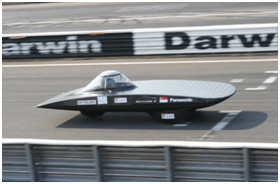 | |
25 October 2009
Race Day 1: Team NTU sets off for the gruelling 3000km race! 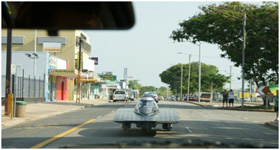 | |
26 October 2009
Race Day 2: Team NTU finished the day at 826km mark at Renner springs.
27 October 2009
Race Day 3: Team NTU cleared Check Point 4 and ended the day at the 1260km mark.
28 October 2009
Race Day 4: Team NTU trailered past checkpoint 5 and 6 today to make up for lost time before switching back to solar power.
29 October 2009
Race Day 5: Team NTU at 2432 km
from starting point at Glendambo outback resort and gearing up for final stretch tomorrow.
30 October 2009
Race Day 6: Team NTU arrives in Adelaide but fell slightly short of crossing the finishing line
by the 5pm deadline.
31 October 2009
Race Day 7: Today officially marks the end of Nanyang Venture II’s journey as it crosses the finishing line.  | |
1 November 2009
Release of official results:
Nanyang Venture II ranks 11th in the World Solar Challenge race. Well done, Team NTU! | |
